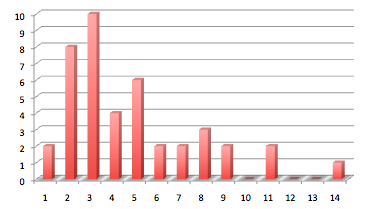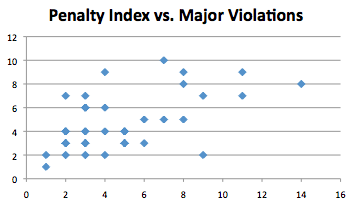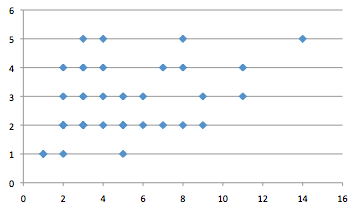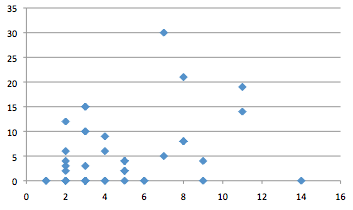This is a follow up article to my original analysis of NCAA football penalties through the years. Â Although I had planned to get this out earlier, life has intervened. Â In the end, though, it’s perhaps instructive to look one more time just ahead of UNX’s pre-Halloween date with the NCAA.
In this analysis, I will dive into the actual case details during the BCS era to determine if we can see patterns and trends within the data. Â In particular, I would like answers to the following questions posed by the original high-level analysis:
- Does probation really mean anything?
- Are the number of infractions predictive of the eventual penalties?
Probation
First the basics: from the previous article we know that there have been 42 reported cases during the BCS era. Â Of these cases, only 6 were the result of a school re-offending during the timeframe. Â The following schools had two cases: Alabama, Colorado, FIU, Georgia Tech, Texas Tech, and USC. Â No school had more than two. Â Of these 6, only FIU was cited for repeat violations while on probation.
Digging into the FIU case files, this was a case of a school playing its very first football game in 2002 as Division 1-AA, then jumping to Division 1 in 2005, and they were cited in the 2008 news release as the “textbook example of what happens when a program moves to Division I-A without the necessary administrative structure to support the move.” Â So this is really an outlier based on LOIC due to incompetent administration.
There is interesting language in the 2008 FIU case file, however, that bears examination. Â In the penalties section, the following text appears:
“The institution was both a repeat-violater and on probation as a result of a previous infractions case. Â In light of the institution’s status as a repeat violator, the committee considered imposing a postseason ban.”
This language suggests that the NCAA does consider probation when determining penalties, and that they have some leeway in making those determinations. Â It’s unfortunate that there were no examples where they elected to bite rather than just bark. Â So I’ll just have to be unsatisfied, and have no answer to Question #1.
Penalty Prediction
To start, let’s look at penalties compared to number of major violations cited. Â During this period, the severity ranged from one major (Kansas State, 1999 and Illinois, 2005) to 14 majors (Baylor, 2005). Â The distribution looks like:
As you can see, the majority of cases involve 5 or fewer major violations. Â So the obvious question is “can we predict penalties based on the number of major penalties cited?” Â In order to do that, we need to either examine each penalty type independently, or create an aggregate index that represents the sum total of penalties. Â For the first stab, I’ll define a penalty index as the sum of all TV ban years, post-season ban years, and probation years, plus one additional unit for each of the four areas of additional penalty: financial, recruiting, show-cause, and vacation. Â The results look like this:
Sorry for the ugly chart, but I’ve been in a bit of a rush. Â The x-axis is “Number of Major Violations” and the y-axis is “Penalty Index” as defined above. Â So much for the penalty index. Â Maybe the COI’s rationale correlates at a lower level, so let’s give that a try.
We’ll start with probation – it’s a good place to start, since every case involves at least one year of probation. Â The correlation here looks like:
Again, we have “Number of Majors” as the x-axis, and “Years of Probation” as the y-axis. Â Pretty much looks the same to me, so little help here.
Eyeballing a couple of other possible avenues:
- For teams that did NOT receive a post-season ban, the number of majors ranged from 1 to 14
- For teams that did receive a post-season ban, the number of majors ranged from 4 to 11
Although there are a number of other avenues I could go down, it looks very much like the data confirms our “gut” feelings: the seemingly logical assumption that penalties would correlate to number of majors is coming up empty.
As a last-ditch effort, let’s look at scholarship reductions, in detail. Â Such reductions can either be limits in “initial” grants-in-aid (scholarships for new members to the team) or to total grants-in-aid. Â The NCAA limits schools to 25 initials per year and 85 total per year. Â There seemed to be no pattern to whether the NCAA would limit “initial”, total, or both. Â To correlate this, I will be using the greater of the two for each year that a limit was imposed. Â Some general observations about this data:
- Total number of scholarship-years penalized per case ranged from 0 to 30.
- From 1998-2003, the severity of scholarship reductions was more severe than in subsequent years
So let’s try one last time to correlate the reductions to the number of major infractions:
Again, we have “Number of Majors” as x-axis and “Total Scholarship-Years” y-axis.
I give up. Â Perhaps with a great deal of time and energy, a better analyst might find a correlation somewhere, but I’m not betting what’s left of my 401K on it.
What does this mean for UNX?
So as a final bit of input, let’s look at the small number of cases (5) where the number of major violations equals or exceeds those of UNX. Â This will ignore all the “touchy-feely” crap that gets dispensed, like “public reprimand and censure” and “change compliance procedures”, “vacation of wins”, etc. Â It will focus on penalties that substantially penalize the program:
1) Texas Tech, 1998: 11 major violations, including LOIC
Self-imposed:Â No participation in 1997 Big 12 championship game, post-season ban 1997, reduce official visits from 62 to 40, reduce number of coaches permitted to recruit off campus from 7 to 5, reduce initial grants from 25 to 17 for 1998-1999 and from 25 to 19 for 1999-2000, reduce evaluation days from 20 to 15, and evaluation opportunities from 140 to 90.
Added by NCAA:Â Reduce initial grants from 25 to 21 for year 2000-2001, and total grants from 85 to 80 during 1999-2000 and 2000-2001, show-cause for one assistant coach
2) Kentucky, 2002: 11 major violations, including LOIC
Self-imposed:Â Reduce initial grants from 25 to 16 in 2002-2003, to 18 in 2003-2004, and to 22 in 2004-2005, reduce official visits to 36 in 2001-2002 and 40 in 2002-2003, reduce coaches recruiting off campus by one
Added by NCAA:Â bowl ban for 2002, reduce total grants from 85 to 80 for each season 2003-2005
3) Rutgers, 2003: 9 major violations, including LOIC
Self-imposed:Â reduce initial grants by a total of four (not four each) during the three seasons 2003-2005
Added by NCAA:Â nothing substantive
4) Baylor, 2005: 14 major violations, including LOIC
Note: this case is multi-sport, primarily concerned with the men’s basketball program, with some small overlap in the football program. Â There were very few penalties associated with football.
5) Ohio State, 2006: 9 major violations, NOT including LOIC
Note: this case is also multi-sport, covering men’s basketball and football. Â Again the most serious penalties were levied against the basketball program.
And just for grins, let’s look at the more recent USC case:
6) USC, 2010: 7 major violations, including LOIC
Self-imposed: none documented
Added by NCAA: 2 year post-season ban, reduction by 10 of both initial and total grants for each of the years 2011-2012, 2012-2013, 2013-2014, return of $206,020 from the Pac-10 conference, prohibition of non-institution personnel from attending or participating in football camps, and from access to the sidelines during games and practice, show-cause on an assistant coach
Conclusions
- There is consistent language in several of the case files that suggests the NCAA will use existing probation and “repeat-offender” status as input into the penalty determination. Â But there is very little demonstration of this.
- There is virtually no correlation between the number of major violations and any penalty assessment.
__________________________________
Prediction for Friday:
UNC, 2010: 9 major violations, NOT including LOIC
Self-imposed:Â reduction of total grants by 2 in each of three seasons 2011-2013
Added by NCAA:Â reduction of initial grants and total grants by 4 in each of the three seasons, show-cause for Santa
The NCAA will also likely increase the probation from 2 to 3 years (probably meaningless), and agree to the vacation of wins that is self-imposed (absolutely meaningless). Â I really think that will be all.
There was almost zero traction to the recruiting prong, so I’ll be very surprised to see any recruiting limits. Â It’s possible we may see a monetary fine, but I don’t think it will be large enough to matter.
I sincerely hope I’m wrong about all this, and that the NCAA surprises all of us with a firm penalty for the unprecedented wrongdoing over on the hill. Â If it does not, look for this kind of activity to become commonplace, to the detriment of programs that try to do the right thing, and to our perception of amateurism in collegiate football.
Last word: I stand by my statement delivered in Part I: Who says cheating doesn’t pay?







You must be logged in to post a comment.